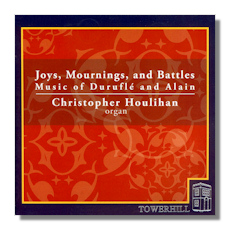
The Internet's Premier Classical Music Source
Related Links
-
Alain Reviews
Duruflé Reviews - Latest Reviews
- More Reviews
-
By Composer
-
Collections
DVD & Blu-ray
Books
Concert Reviews
Articles/Interviews
Software
Audio
Search Amazon
Recommended Links
Site News
 CD Review
CD Review
Joys, Mournings, and Battles

Organ Music
- Maurice Duruflé:
- Suite for Organ
- Prelude & Fugue on A.L.A.I.N.
- Jehan-Ariste Alain: Three Dances, AWV 119/Op. 81
Christopher Houlihan, organ
Rice Memorial Organ, All Saints Church, Worcester, Mass.
Towerhill Recordings TH-72025 63:45
Christopher Houlihan is a young organist from Connecticut. Just 27, he has already performed highly acclaimed recitals across the United States, and is a major voice in bringing organ music back into the mainstream. As he is passing through what is essentially my hometown on tour this year, I was asked to review his two CDs to date, both of which are excellent.
This is the latter one, from 2010. The Rice Memorial Organ at All Saints Church is a richly colorful one, and sounds wonderful as recorded here. Houlihan has no problems drawing a wide variety of sound and expression from this impressive instrument. The virtuosity is unquestionable; listen to the almost unsettling ease with which the organist dispatches the Suite's final movement. In the quieter moments, there is true artistry and intellect. The recording captures everything faithfully, with admirable detail even when there is a good deal going on. Maybe organ fans might want a deeper bass – it's a naughty thrill – but overall, the decision to balance everything carefully is in the best interest of the music.
Speaking of which, I find the pieces here somewhat unconvincing. There are times in the opening Suite where literally nothing happens musically – just a long, sustained note. This happens too often for my taste, despite the young organist's obvious care and attention to keeping the music fresh. Also, not even the composer liked the concluding Toccata. I'm not sure I do either, although the playing is again magnificent and almost jaw-dropping in power. Duruflé's other contribution, the Prelude and Fugue on the name of A.L.A.I.N. is frankly better music. The haunting opening Prelude is wickedly difficult; here it sounds easy. Additionally, the instrument suits it very well. The concluding Fugue is aptly majestic.
Alain himself is represented by his Three Dances which form a bridge for the outer works on the program. Let's leave aside the fact that perhaps no instrument is less suited for "dances" and concede that this is predictably colorful and inventive music. Houlihan is actually able to make this music dance. For a lack of a better term, this is cool. The agility with which Houlihan is able to attack his instrument and rock out the rhythms is nothing short of impressive. The almost percussive effects of the opening notes in Battles (the third movement) are inventive and hopefully intentional. While it's not so much war music as it is militaristic – there's some neat stuff going on here – the overall results testify to a man who clearly knows what he's doing. Not the greatest music overall, but one heck of a display. Organ fans should snap this up!
Copyright © 2014, Brian Wigman


















